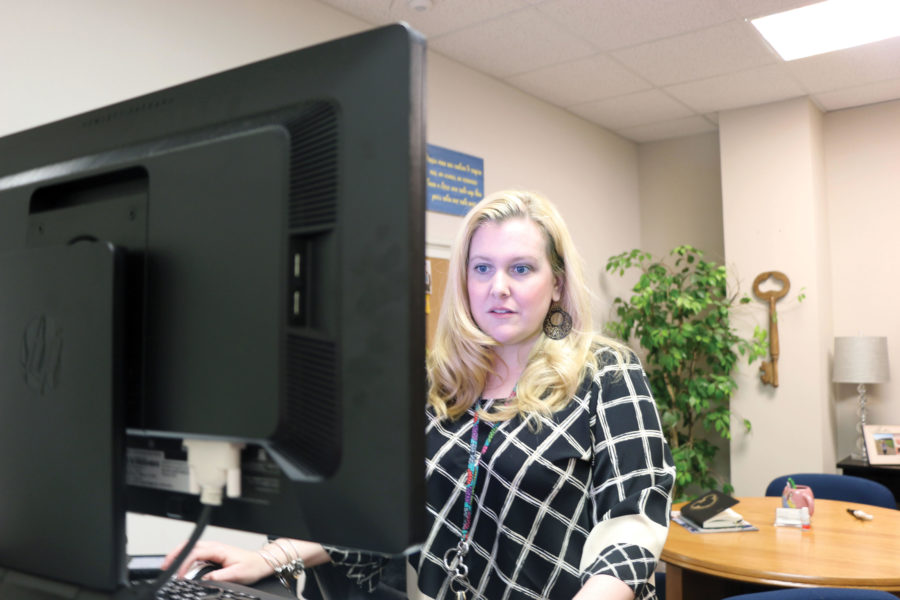To most students, the bell at the end of fourth period signals the end of school. But, for Claire Estabrook, Instagram model and senior, it is not only the end of the school day but also the start of a time when she can focus more on her social media accounts online as a model.
Estabrook is not alone; in fact, she is part of a growing number of people who devote a significant amount of time on social media. With its popularity, Estabrook said she felt while there are more supportive people on social media, there are also more haters who harassed her through social media.
She said, “It’s very common through social media to see harassment, but when I have 44,000 followers, it’s very common that one of the 44,000 will say something bad every day.”
School resource officer Scott Moore said he agrees with Estabrook in that online harassment is a very prevalent issue.
“(Online harassment) goes on a lot at CHS. I think most of it starts (at) school and (then) goes online,” Moore said. “I don’t want to be mean to your generation, but people feel more connected now on the internet than (what) it was like when I was (growing up). We didn’t have all this social media, which is the main reason for the rise of (online harassment).”
Although most people agree that online harassment is a rising issue, the majority of Americans disagree over what online harassment is, according to a 2018 Pew Research study.
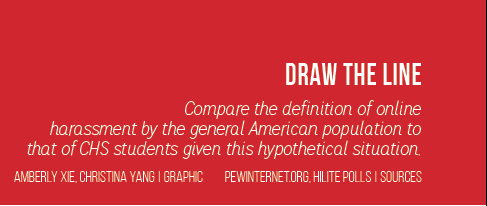
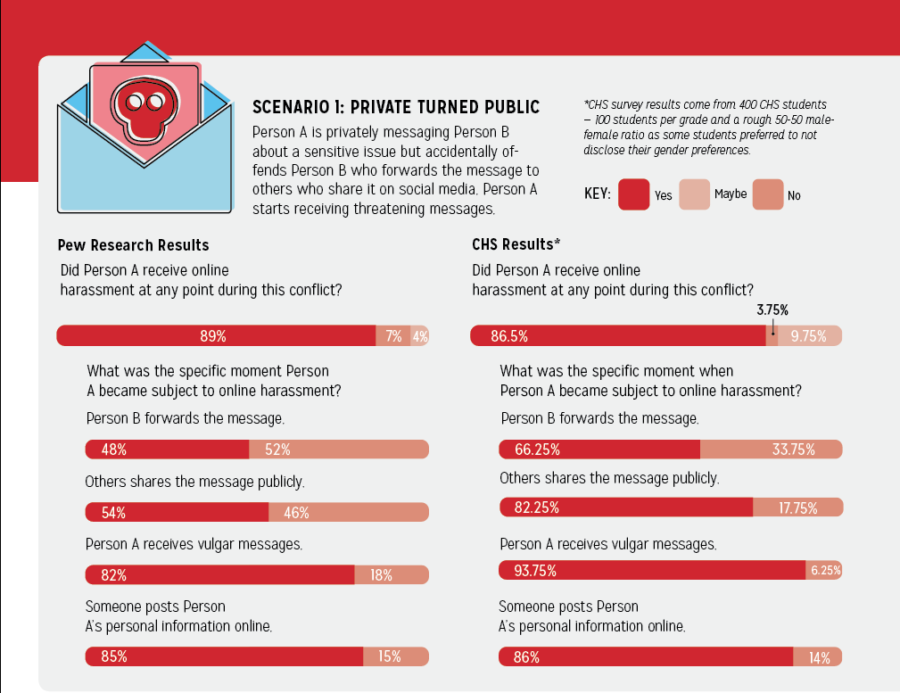
Assistant principal Brittany Wiseman said she has seen her share of online issues and defines online harassment as an online act done intentionally to annoy or provoke someone.
“Let’s say there were five people in that closed group, and I post (something bad) about someone not in that closed group,” Wiseman said. “While that person is mean and cruel, I don’t view that as online harassment because they are not putting that directly towards that other person. I think they are being cruel and that someone needs to change their behavior. But it’s not online harassment.”
Moore said he also believes online harassment is direct.
“Online harassment is anything that’s sent to you online electronically that’s hurtful or threatening,” he said.
On the other hand, Estabrook said she believes whether the conflict occurs indirectly does not matter.
“(Online harassment) is cyberbullying. It can be anything from people posting things about others on their finstas, or people saying awful things. But, I think continuous (cyberbullying) makes it harassment,” Estabrook said.
Mirroring the results of the Pew Research survey, online harassment does not have a clear definition. Students and staff offer different viewpoints on its definition, but both said they agree everyone should know how to handle such situations.
“First thing the student needs to do is to go to a counselor. Counselors intervening with the student’s situation sometimes can help put it to rest early,” Moore said. “But what I like to tell kids all the time is, ‘If you’re uncomfortable with social media, let somebody know.’ Some students keep things inside and that just leads to a lot of anxiety. The sooner you talk about a problem you’re having or anything with somebody in life, a resolution can be found quickly.”
Estabrook said one way to deter online harassment is becoming open with the idea of blocking someone.
“A lot of people have a really hard time blocking people for some reason. I think it’s because we are just drawn to the drama, but I’ve been there and understand why,” she said. “I would tell other students who are getting harassed online, ‘Hey if you don’t wanna block them, I understand, but don’t try to talk it out because it’ll just make you mad and make them mad and (then) they get what they want.’ If you really want them to stop, don’t answer and just live your life. Prove them wrong. That should be the goal.”
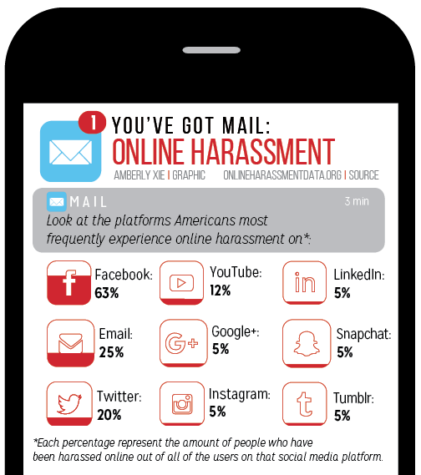
Wiseman said she agrees with the idea there should be self-imposed limits on who should follow whom.
“Do not follow anyone you would not cross the street to go talk to,” she said. “I follow John Mayer and Jimmy Fallon because I would totally cross the street to go talk to them, but I’m not going to follow someone I went to high school with 20 years ago. I might do the wave across the street, but why would I say ‘Yeah you can follow me’ or why would I follow them. I don’t talk to them. I’m not going to cross the street to say ‘Hi’ to the random person in the math class because sometimes we help each other. I might do the wave and say ‘Hey,’ but I’m not crossing the street for them. So don’t follow them, and don’t let them (on social media) follow you. Have a little bit of a private life.”




























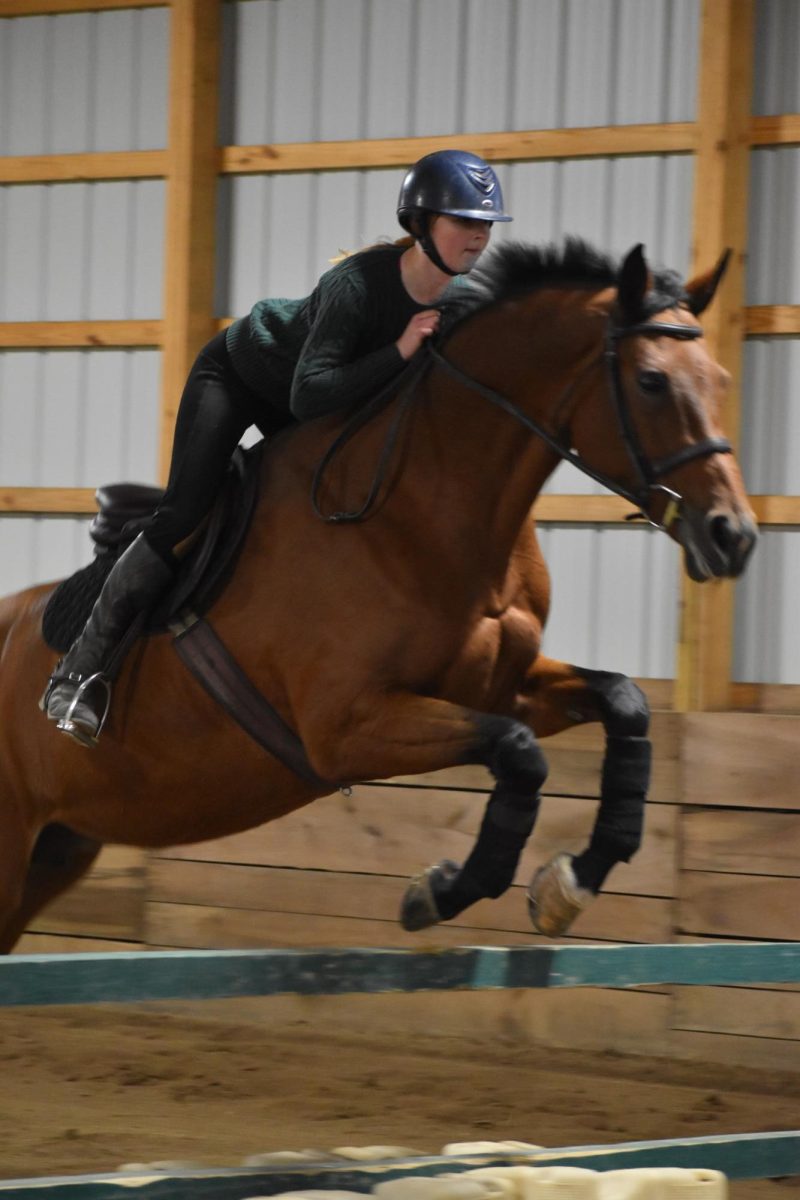





![British royalty are American celebrities [opinion]](https://hilite.org/wp-content/uploads/2024/03/Screenshot-2024-03-24-1.44.57-PM.png)



















![Chelsea Meng on her instagram-run bracelet shop [Biz Buzz]](https://hilite.org/wp-content/uploads/2024/04/IMG_2446-1200x838.jpg)
![Review: Quiet on Set: The Dark Side of Kids TV is the long awaited exposé of pedophilia within the children’s entertainment industry [MUSE]](https://hilite.org/wp-content/uploads/2024/04/unnamed.jpg)
![Review: “The Iron Claw” cannot get enough praise [MUSE]](https://hilite.org/wp-content/uploads/2024/04/unnamed.png)
![Review: “The Bear” sets an unbelievably high bar for future comedy shows [MUSE]](https://hilite.org/wp-content/uploads/2024/03/unnamed.png)
![Review: “Mysterious Lotus Casebook” is an amazing historical Chinese drama [MUSE]](https://hilite.org/wp-content/uploads/2024/03/0.webp)
![Review in Print: Maripaz Villar brings a delightfully unique style to the world of WEBTOON [MUSE]](https://hilite.org/wp-content/uploads/2023/12/maripazcover-1200x960.jpg)
![Review: “The Sword of Kaigen” is a masterpiece [MUSE]](https://hilite.org/wp-content/uploads/2023/11/Screenshot-2023-11-26-201051.png)
![Review: Gateron Oil Kings, great linear switches, okay price [MUSE]](https://hilite.org/wp-content/uploads/2023/11/Screenshot-2023-11-26-200553.png)
![Review: “A Haunting in Venice” is a significant improvement from other Agatha Christie adaptations [MUSE]](https://hilite.org/wp-content/uploads/2023/11/e7ee2938a6d422669771bce6d8088521.jpg)
![Review: A Thanksgiving story from elementary school, still just as interesting [MUSE]](https://hilite.org/wp-content/uploads/2023/11/Screenshot-2023-11-26-195514-987x1200.png)
![Review: When I Fly Towards You, cute, uplifting youth drama [MUSE]](https://hilite.org/wp-content/uploads/2023/09/When-I-Fly-Towards-You-Chinese-drama.png)
![Postcards from Muse: Hawaii Travel Diary [MUSE]](https://hilite.org/wp-content/uploads/2023/09/My-project-1-1200x1200.jpg)
![Review: Ladybug & Cat Noir: The Movie, departure from original show [MUSE]](https://hilite.org/wp-content/uploads/2023/09/Ladybug__Cat_Noir_-_The_Movie_poster.jpg)
![Review in Print: Hidden Love is the cute, uplifting drama everyone needs [MUSE]](https://hilite.org/wp-content/uploads/2023/09/hiddenlovecover-e1693597208225-1030x1200.png)
![Review in Print: Heartstopper is the heartwarming queer romance we all need [MUSE]](https://hilite.org/wp-content/uploads/2023/08/museheartstoppercover-1200x654.png)






















![Review: Ladybug & Cat Noir: The Movie, departure from original show [MUSE]](https://hilite.org/wp-content/uploads/2023/09/Ladybug__Cat_Noir_-_The_Movie_poster-221x300.jpg)

![Review: Next in Fashion season two survives changes, becomes a valuable pop culture artifact [MUSE]](https://hilite.org/wp-content/uploads/2023/03/Screen-Shot-2023-03-09-at-11.05.05-AM-300x214.png)
![Review: Is The Stormlight Archive worth it? [MUSE]](https://hilite.org/wp-content/uploads/2023/10/unnamed-1-184x300.png)




![Seniors Jillian Rang and Athul Ramkumar practice their presentation at the DECA state competition on March 5, 2024. Arya Patel, DECA paper head and junior, said, As they [students] begin to make their final preparations, its important to remember that making it to this point is an incredible achievement.](https://hilite.org/wp-content/uploads/2024/04/IMG_8285-1200x800.jpg)
